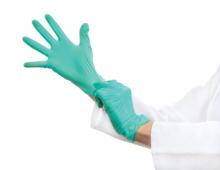SAN FRANCISCO – A new skin prick test detects type-1 hypersensitivity to nitrile, the synthetic rubber in the gloves increasingly used by hospitals.
With latex allergies not uncommon among health care workers, "most hospitals have been switching over to nitrile gloves," said allergist and immunologist Dr. Santhosh Kumar of Virginia Commonwealth University, Richmond.
But nitrile gloves can cause reactions, too, a problem not often recognized in the medical community and one that may emerge as a significant issue with expanded use, he said.
Since hospitals have been making the switch, "We’ve seen more and more people present with contact sensitivity [to nitrile], with hives and rashes on their hands. Some have it all over their body. It starts off initially on the hands, and then it gradually progresses," Dr. Kumar said.
To detect nitrile hypersensitivity, "we came up with a new skin prick test," he said.
Dr. Kumar and his colleagues tried it out on three people who had reacted to nitrile gloves in the past.
They cut 5-cm-square pieces from blue and purple nitrile gloves, and soaked them in normal saline for 2 hours.
They then applied the pieces to the underside of the patients’ forearms, and pricked the skin through the patches with Greer DermaPIKs. The pieces were removed and rubbed over the pricked areas a few times.
Skin tests were read 15 minutes later and considered positive if the wheal was 3 mm larger than saline control pricks.
All three patients had positive tests with mean wheal diameters of 5.5 mm. The mean saline prick wheal diameter was 2.17 mm, the mean diameter of histamine pricks—also used as controls—was 5.17 mm.
Latex IgE was positive in the one patient who had previously reacted to latex gloves.
The test "is a simple and effective method to detect type-1 hypersensitivity reactions to nitrile products," Dr. Kumar and his colleagues concluded.
"If a patient is positive, we tell them to avoid nitrile gloves," he said. Vinyl gloves are option, though less elastic than latex and nitrile.
Dr. Kumar said he has no disclosures.


